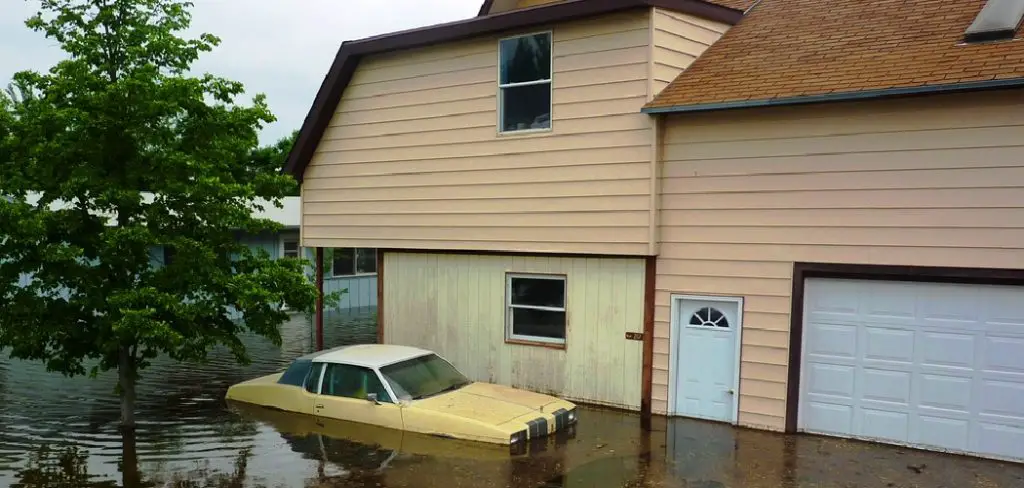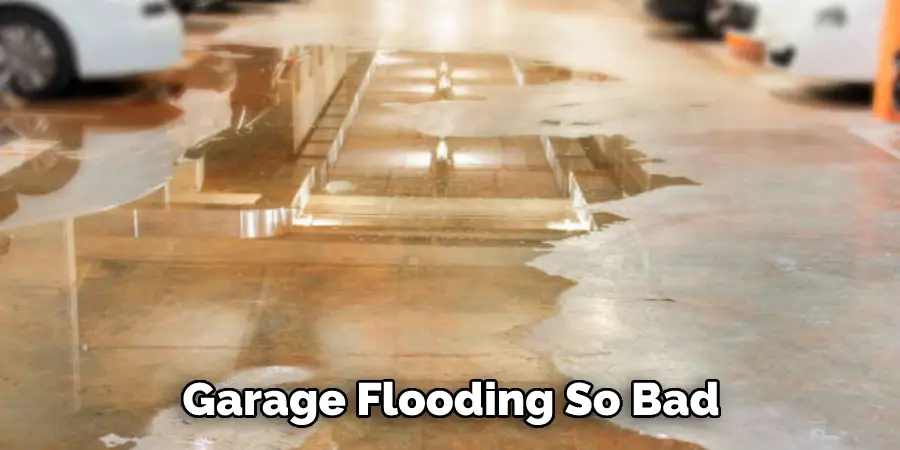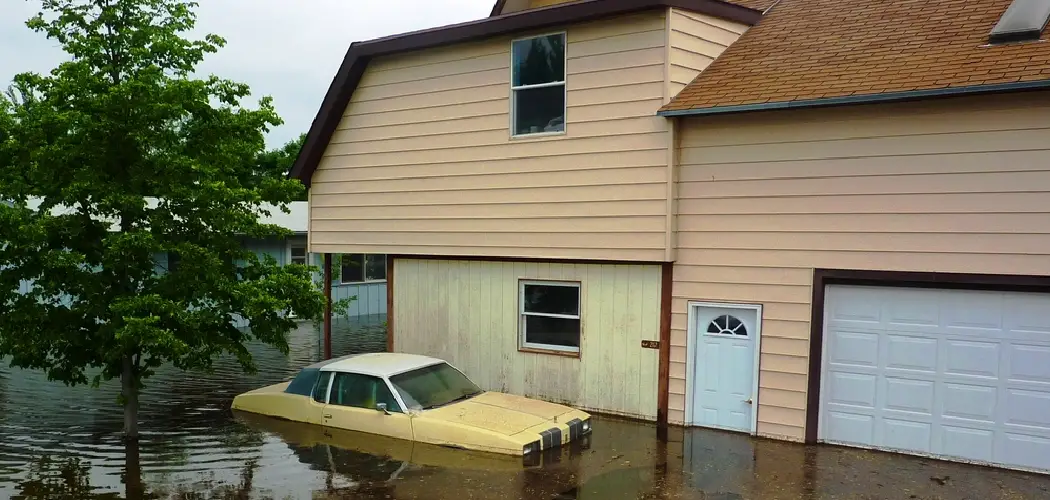If your garage is flooding, you’re not alone. Thousands of homeowners experience this issue every year. The good news is that there are actions you can take to stop the flooding and protect your home and belongings. In this blog post, we’ll discuss a few tips on how to stop garage flooding. We’ll also provide information on what to do if your garage has flooded. Keep reading for more information.

Summary: Garage flooding is a common problem homeowners face, which can lead to water damage, mold growth, and costly repairs. You can take a few steps to prevent this from happening. First, ensure that the garage floor is sloped away from the house. Second, seal any cracks in the floor or walls. Third, install a sump pump to remove any water that may accumulate. Finally, make sure your gutters and downspouts are clear to allow water to flow away from your garage.
What Causes Garage Flooding?
There are a few different reasons why your garage might flood. One common cause is heavy rains. If the rain comes down too hard or fast, it can overwhelm your gutters and downspouts. This can cause water to seep into your garage through cracks in the foundation or doors and windows. Another common cause of garage flooding is a broken pipe. A burst water pipe can quickly fill up your garage with water.
If you have a sump pump, it might not be able to keep up with the influx of water. Finally, your garage is at risk of flooding if your home is located in an area with a high water table. It doesn’t take much for the water table to rise and cause water to seep into your garage.
Why Is Garage Flooding So Bad?
Garage flooding is a serious problem because it can damage your belongings and your home. Water can ruin your tools, lawn equipment, and other belongings that are stored in your garage. In addition, water can damage your garage door, drywall, and foundation.
You might even have to replace your garage if the flooding is severe. This can be a costly repair. It also creates a perfect environment for mold and mildew to grow. Mold and mildew can cause health problems, so it’s important to address the issue as soon as possible.

A Complete Guide on How to Stop Garage Flooding
Step 1: Assess the Cause of Flooding
Before attempting to stop garage flooding, determine the cause of the issue. Possible causes may include poor drainage around the garage, damaged or clogged gutters, a leaking roof, or a high water table. Identifying the source of the flooding will help guide your efforts to resolve the problem effectively.
Step 2: Improve Exterior Drainage
If poor drainage around the garage is causing flooding, take measures to improve the flow of water away from the structure. This can include:
- Grading the soil around the garage to create a slope away from the foundation
- Installing a French drain or trench drain to direct water away from the garage
- Extending downspouts from the gutter system to discharge water farther from the foundation
- Installing a catch basin or dry well to collect and disperse excess water
- Utilizing permeable paving materials, such as gravel or permeable pavers, for the driveway or other surfaces around the garage
Step 3: Clean and Repair Gutters
Clogged or damaged gutters can cause water to overflow and pool around the garage, leading to flooding. Regularly clean gutters and downspouts, removing leaves, twigs, and other debris that can cause blockages. Inspect the gutter system for damage or leaks and make necessary repairs or replacements to ensure proper function.
Step 4: Repair Roof Leaks
A leaking roof can cause water to enter the garage and lead to flooding. Inspect the garage roof for signs of damage or wear, such as missing or broken shingles, deteriorated flashing, or cracked sealant. Make necessary repairs or consult a roofing professional for assistance.
Step 5: Install a Sump Pump
If your garage is prone to flooding due to a high water table or other factors, consider installing a sump pump. This device will collect water in a pit or basin and automatically pump it away from the garage when water levels rise. Consult a professional to determine the appropriate type and size of the sump pump for your situation and to ensure proper installation.
Step 6: Seal Garage Floors and Walls
Prevent water infiltration by sealing the garage floor and walls with a waterproofing compound. This can be applied to concrete or masonry surfaces to create a barrier against moisture. Follow the manufacturer’s instructions for application and drying times.
Step 7: Install Flood Barriers
Consider installing flood barriers, such as sandbags or water-filled barriers, around the garage during periods of heavy rainfall or potential flooding. These barriers can help to prevent water from entering the garage and can be easily removed and stored when not in use.
Step 8: Elevate Valuables and Electrical Components
Raise valuable items and electrical components, such as outlets and wiring, above the potential flood level to prevent damage. Store items on shelves or in waterproof containers, and consult an electrician to ensure electrical components are safely elevated.
Step 9: Regularly Inspect and Maintain Garage
Prevent garage flooding by regularly inspecting and maintaining the garage and its surrounding area. Check for signs of water infiltration or damage, ensure gutters and downspouts are clear and functioning properly, and maintain the drainage system to keep water flowing away from the structure.
Step 10: Create an Emergency Response Plan
Develop an emergency response plan for potential garage flooding situations. This plan should include:
- A list of emergency contacts, such as local authorities, utility companies, and insurance providers
- Instructions for shutting off utilities, such as electricity and gas, in the event of a flood
- An inventory of valuable items stored in the garage, including photographs and descriptions, to assist with insurance claims
- A designated location for storing flood barriers and other flood prevention materials
By following these steps, you can effectively prevent and manage garage flooding, protecting your property and valuables from water damage. Regular maintenance and proactive measures will help to minimize the risk of flooding and ensure that your garage remains a safe and functional space.
Step 11: Install a Garage Door Threshold Seal
A garage door threshold seal can be installed along the bottom of the garage door to create a watertight barrier between the garage floor and the door. This seal can help to prevent water from seeping under the door and entering the garage. Choose a high-quality, durable threshold seal made from materials such as rubber or vinyl and follow the manufacturer’s instructions for proper installation.
Step 12: Waterproof Garage Door
To further protect your garage from flooding, consider waterproofing the garage door. This can be achieved by applying weatherstripping or weather seals around the edges of the door to create a barrier against water infiltration. Inspect the weatherstripping periodically for signs of wear and replace it as needed to maintain its effectiveness.
Step 13: Inspect and Repair Foundation Cracks
Inspect your garage’s foundation for cracks, as they can allow water to seep into the garage and cause flooding. Small cracks can be filled with a waterproof epoxy or hydraulic cement, while larger cracks or structural issues may require professional repair. Regularly inspect the foundation for signs of damage and address issues promptly to prevent further problems.
Step 14: Maintain Proper Ventilation
Proper ventilation is crucial in preventing moisture buildup and potential flooding in your garage. Ensure that vents, windows, and exhaust fans are functioning properly and free from debris or blockages. Regularly inspect and clean these components to maintain optimal airflow and reduce the risk of moisture-related issues.
Step 15: Monitor Weather Conditions
Stay informed about local weather conditions, particularly during periods of heavy rainfall or potential flooding. This will allow you to take proactive measures, such as installing flood barriers or moving valuables to higher ground, to minimize the impact of flooding on your garage.
Step 16: Consider Flood Insurance
If you live in an area prone to flooding, consider purchasing flood insurance to protect your property and belongings. While standard homeowners insurance policies typically do not cover flood damage, a separate flood insurance policy can provide financial protection in the event of a flood. Consult with your insurance provider to discuss your options and determine the appropriate coverage for your needs.
By implementing these steps and maintaining a proactive approach to garage flood prevention, you can effectively reduce the risk of water damage and protect your property. Regular inspection, maintenance, and the use of appropriate flood prevention measures will help to ensure the safety and longevity of your garage and its contents.
Some Precautions on How to Stop Garage Flooding
- Don’t let rainwater accumulate near your garage doors or gutters.
- Inspect your garage door regularly for cracks and gaps that could let water in.
- If you have a garage door opener, make sure the sensors are clean and unobstructed.
- Consider installing a backwater valve to prevent sewage from backing up into your garage.
- Make sure the floor drain in your garage is clear and functioning properly.
- Keep an eye on the weather forecast and be prepared to take action if a significant storm is expected.
How Much Does Garage Flooding Cost?
The cost of garage flooding can vary depending on the extent of the damage. If your garage is only partially flooded, you may be able to clean it up yourself. However, if the flooding is severe, you may need to hire a professional to do the job. Hiring a professional can range from $500 to $5,000.
Conclusion
This article provides an overview of how to stop garage flooding. Following these simple steps can keep your garage and belongings safe and dry. Have you tried any of these methods to stop your garage from flooding? Let us know in the comments below!
You Can Check It Out to Keep Floor From Sweating


